Dumbarton Burgh and County Tramways
History
Dumbarton's tramway story began in earnest in 1902, when the Corporation obtained powers to generate and supply electricity within the Burgh. Prior to this, it had been approached by the electrical engineers, Crompton and Company Limited, who were interested in constructing and operating the electrical infrastructure. On the 3rd April 1903, agreement was reached between the two parties, which not only included the infrastructure for electricity generation and supply, but which also revived earlier plans for an electric tramway, both within the town and outside it. Following construction, operation of the power station and the tramway was to be handed over to the Electricity Supply Corporation Limited, the operating arm of C&Co.
Powers to build the tramway within the Burgh were obtained on the 24th March 1904 — under the Dumbarton Tramways Order Confirmation Act of 1904 — but those outside it were much delayed, only being obtained on the 21st December 1906 under the Dumbartonshire Tramways Order Confirmation Act of 1906. The delay in acquiring the latter powers was mostly due to objections from Dumbarton County Council, along whose roads much of the new tramways would run, the council extracting some expensive commitments from the C&Co in return for its support.
Construction of the tramway lines within the Burgh started at the end of March 1905. The two-year delay between acquiring the powers and construction starting was due to the C&Co, which was hoping to secure cheaper electricity from a hydroelectric scheme, one that ultimately failed.
The first overhead electric tramway services commenced on the 20th February 1906, and were operated by the ESCL with just six tramcars. These first lines were wholly within Dumbarton Burgh, running from Dumbuck in the east to Dalreoch in the west, with a short branch out to Barloan; in practice, the services usually stopped short of the municipal boundaries — at Dumbuck Greenhead Road and Dalreoch Toll, these being more conveniently situated for passengers.
The ESCL set up a new company to operate the tramway in 1907, the Dumbarton Burgh and County Tramways Company Limited, to which its tramway assets and powers were transferred, this being confirmed on the 28th August 1907 under the Dumbarton Burgh and County Tramways Order Confirmation Act of 1907. The ESCL retained a major shareholding in the new company.
Construction of the tramways outside Dumbarton Burgh commenced on the 18th February 1908, the first section — to Alexandria Fountain — opening barely ten weeks later on the 7th May 1908. The sections from Alexandria to Balloch (Loch Lomond), and eastwards from Dumbuck to West Dalmuir, followed on the 10th June 1908. The last new line, the branch from Alexandria to Jamestown, had to wait until 24th February 1909, as the County Council refused to allow the roadway under the railway bridge in Bank Street (Alexandria) to be lowered. In the end, the company gave way, purchasing four lower vehicles, secondhand from Glasgow Corporation Tramways; bizarrely, these were double deck, but for their entire working lives, were not allowed to carry passengers on the upper deck (due to the bridge). These four vehicles brought the fleet up to thirty tramcars.
The Jamestown line took the DB&CTCo's 4ft 7¾ins-gauge, overhead electric tramway to its final size of 13.1 miles. The system comprised a main line running westwards from Duntocher Burn (West Dalmuir), through Old Kilpatrick, Bowling, Dumbuck, and Dalreoch, then northwards through Renton and Alexandria to a terminus in Balloch Road, just before it was crossed by the Dumbarton and Balloch Joint Railway. In addition, there were two branch lines, one running northwards from Dumbarton High St, along Church St and Bonhill Street to a terminus at Barloan Toll, and the other running southeastwards from Alexandria Fountain, along Bank Street, and through Bonhill, then northwards to a terminus on Levenbank Terrace, Jamestown.
Meanwhile, at the extreme eastern end of the tramway (at Dunochter Burn, West Dalmuir), the company commenced operation — on the 2nd December 1908 — over 600 yards of Clydebank Corporation-owned tracks to the canal swing bridge on Dumbarton Road. Although these tracks had been built by Glasgow Corporation Tramways (as the intended lessee of Clydebank Corporation), the latter could not as yet operate them, as the system was cut off from the main GCT system by the canal swing bridge, which required rebuilding to accommodate trams. Glasgow and Clydebank Corporations managed to squabble over the costs of the reconstruction for the best part of seven years, GCT services through to West Dalmuir only commencing on the 11th November 1914, at which time DB&CTCo services were cut back to the Clydebank municipal boundary at West Dalmuir. Although through-running between central Glasgow and Loch Lomond (Balloch) would no doubt have been a great boon to both the company and the GCT, it was never implemented.
The Great War brought greatly increased loadings to the tramway, many factories turning to munitions production, whilst weekends brought greatly increased numbers to the shores of Loch Lomond. These operational challenges were compounded by the loss of skilled workers (to the armed forces), lack of spares, and government restrictions on new materials (such as track) all of which led to greatly reduced maintenance. Conductresses were employed from early 1915, with a few women also being trained to drive, though they were restricted to short runs only.
The company first paid a dividend (1.5% on ordinary shares) in 1913, rising to a peak of 5% between 1918 and 1920. The number of passengers carried reached a peak of over five million in 1918, and despite greatly increased costs in 1919 and 1920, the company was evidently still confident enough to order three new tramcars, which were delivered in 1921. Unfortunately, the company's optimism was misplaced, with motorbus competition, which began in early 1919, increasing dramatically throughout the early 1920s. The competition was focused on creaming off the company's lucrative weekend Loch Lomond traffic, which, coupled with a significant trade depression, saw passenger numbers plunge alarmingly.
By 1924, the DB&CTCo belatedly entered the motorbus arena, several of its directors forming the Dumbarton General Omnibus Company Limited on the 6th of May 1924. To add insult to injury, the DGOCo services, which began on the 17th May 1924, ran along the tramway route, so abstracted yet more passengers from the tramway. The tramway track was by now in pretty poor condition, some joint welding seemingly being all that could be done to keep the trams running, it clearly being only a matter of time before serious expenditure (on track renewal) would be necessary.
By 1925, the unregulated motorbus competition had reached hitherto unseen heights, all and sundry seemingly trying their hand. Until this time, the company had still managed to make a profit, though the poor old ordinary shareholders had not seen a dividend since 1920. By 1926, however, the tramway was in serious financial difficulties, passengers numbers sinking by 60%, some of it due to the General Strike, the company defaulting on its debenture payments and summarily deferring its annual wayleave payment to Dumbarton County Council.
There was to be no improvement the following year, and on the 3rd March 1928, the tram services abruptly ceased. At an Extraordinary General meeting of the DB&CTCo on the 16th March 1928, the decision was taken to place the company (presumably excluding the DGOCo) into voluntary liquidation. The sell off of the tramway infrastructure began almost immediately, the company's tramway powers being formally terminated on the 28th January 1929 with the passing of the Dumbarton Burgh and County Tramways (Cessation of Powers) Order. The DB&CTCo was dissolved on the 28th June 1929, its sister company, the DGOCo running its last bus service on the 30th September 1930.
Uniforms
Photographs from the earliest days of the tramway always show tramcar crews wearing long, tailored, single-breasted overcoats. As the men's white shirt collars and ties are always visible, this tends to suggest that any jackets worn underneath would have had lapels (i.e., open necks), though there is a reasonably strong suspicion that jackets were not initially provided. The long, tailored overcoats bore neither insignia nor metal buttons, so they may possibly have been an interim measure. Headgear took the form of tensioned-crown peaked caps; these bore standard, off-the-shelf, script-lettering grade badges, either 'Motorman' or 'Conductor'.
By 1908, tramcar crews were being provided with single-breasted jackets bearing five buttons (possibly plain with a scalloped rim — see link), two breast pockets (with button closures) and stand-up collars. The latter definitely bore an employee number on the bearer's left-hand side, though the situation with the right-hand side remains unclear. It is also unclear whether the badges and buttons were nickel or brass.
The early overcoats were quickly superseded by heavier double-breasted, lancer-style greatcoats, with five pairs of buttons narrowing from top to bottom, epaulettes, and high, fold-over collars; neither the epaulettes nor the collars bore insignia of any kind. The greatcoats usually bore metal buttons with a scalloped rim, but in later years, unmarked, non-metallic buttons were used.
Like their junior colleagues, inspectors appear to have initially been issued with overcoats only. The overcoats were double-breasted with lapels, the collars bearing the grade — 'Inspector' — in embroidered script lettering. At some point, inspectors were issued with typical uniforms for this grade, comprising single-breasted jackets with hidden buttons (or more likely a hook and eye arrangement) and breast pockets. The jackets were edged in material of a finer quality than the main body, and had stand-up collars that bore the grade — 'Inspector' — in embroidered script lettering; the sleeves were embellished with a chevron, again of a finer material than the main body. Inspectors' tensioned-crown peaked caps also bore the grade — 'Inspector' — but on a hat band.
In common with many tramway systems, the DB&CTCo employed female staff during the Great War to replace men lost to the armed forces, initially as conductresses, and subsequently as motorwomen too. At the end of the war, instead of releasing them, as did the overwhelmingly majority of UK tramway operators, the DB&CTCo continued to employ them as conductresses (only), very probably right through until closure. It is unclear why the ladies were kept on, but as several other Scottish systems did the same, there must have been a general shortage of men prepared to work on the trams. Several good quality photographs have survived of these ladies, all of which show them in a rather motley assortment of topcoats and hats, all devoid of insignia, suggesting that they were either self-purchased, or that the company ordered them off a local supplier, as and when needed. It is unclear what jackets, if any, were worn underneath. However, one photograph from the 1920s, which definitely shows a conductress wearing a baggy peaked cap of a type usually referred to as Motor Caps, strongly suggests that a uniform was at some point provided; however, the subject is once again wearing an unmarked topcoat, so the uniform jacket that was presumably worn underneath is unfortunately obscured.
Further reading
For a detailed account of the tramway's history, see: 'Dumbarton's Trams and Buses' by A W Brotchie and R L Grieves; N B Traction (1985).
Images
Motormen and conductors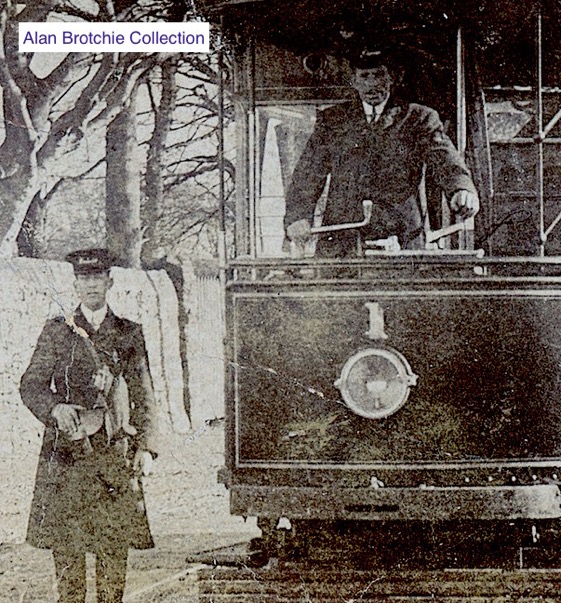
Although of rather poor quality, this photo probably shows the crew of Tramcar No 1 on the opening day — 20th February 1907. Both men are wearing tensioned-crown peaked caps bearing standard, off-the-shelf, script-lettering grade badges, along with collars, ties and tailored overcoats (seemingly devoid of badges).
Script-lettering grade badges of the type worn on DB&CTCo tramcar-crew caps — it is currently unclear whether the company issued these in brass or nickel. Author's Collection.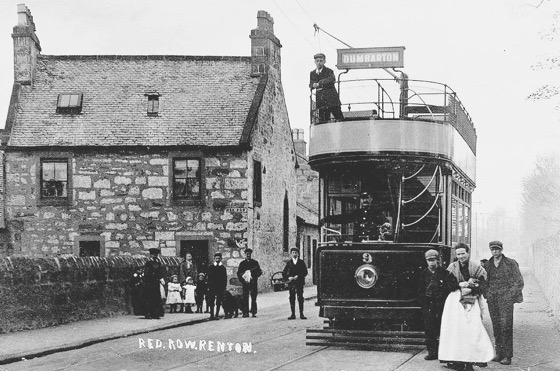
A poor quality image, but one which shows a motorman in the early years of operation, probably in 1908 when the line out to Alexandria and Balloch opened. The subject is wearing a single-breasted jacket and a tensioned-crown peaked cap.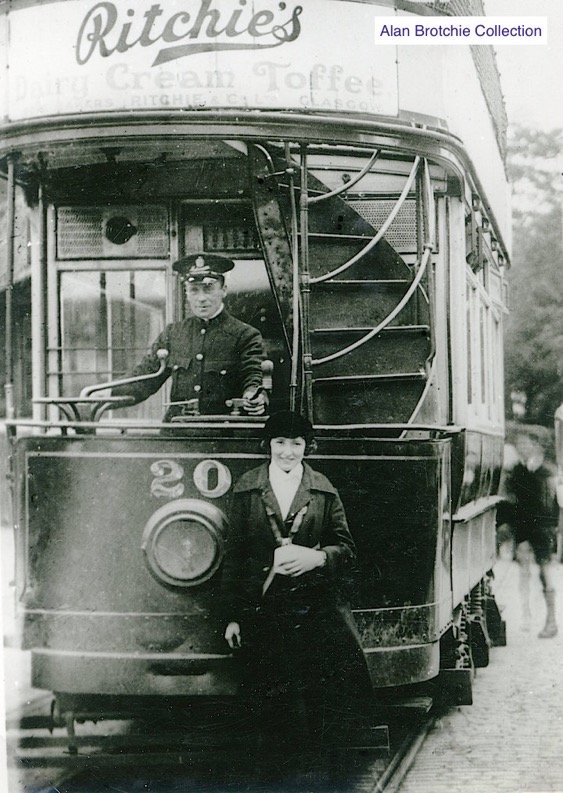
A motorman and a conductress with Tramcar No 20 — photo undated, but probably taken during the Great War.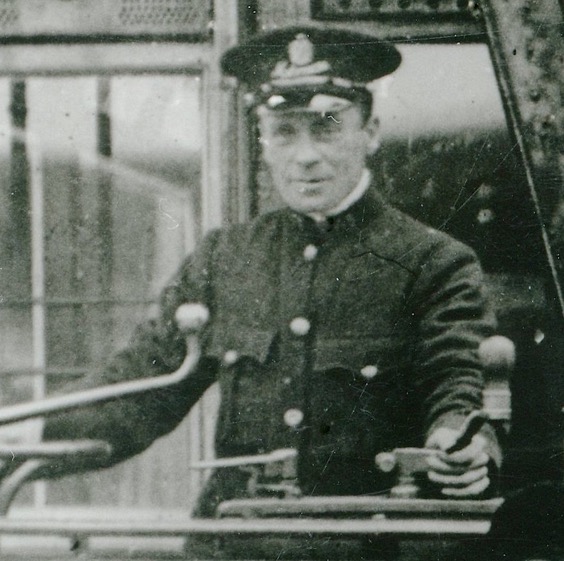
An enlargement of the above photograph showing the motorman; he is wearing a single-breasted jacket with a metal employee number (5) on his left-hand collar. The large badge above his grade badge is more than likely a regimental badge — the wearing of which was common practice amongst tramway employees (countrywide) during and after the Great War.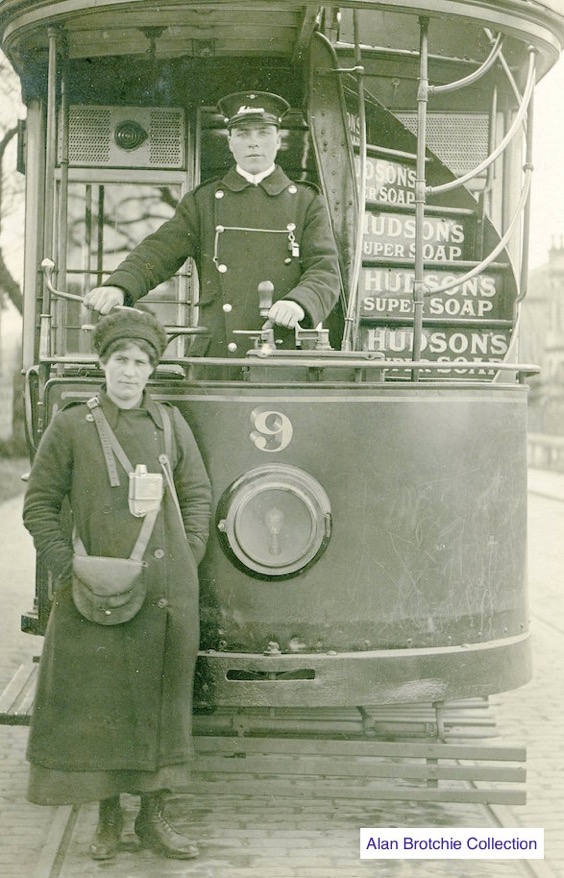
Motorman Charles McKinley and Conductress Helen MacKay pose for the cameraman with Tramcar No 9 at the terminus at Balloch. Although the photograph was purportedly taken on 10th February 1915, this seems a little too early, as if true, it would make the company the first in the British Isles to have employed tram conductresses, when this accolade is generally attributed to Glasgow Corporation Tramways in March 1915.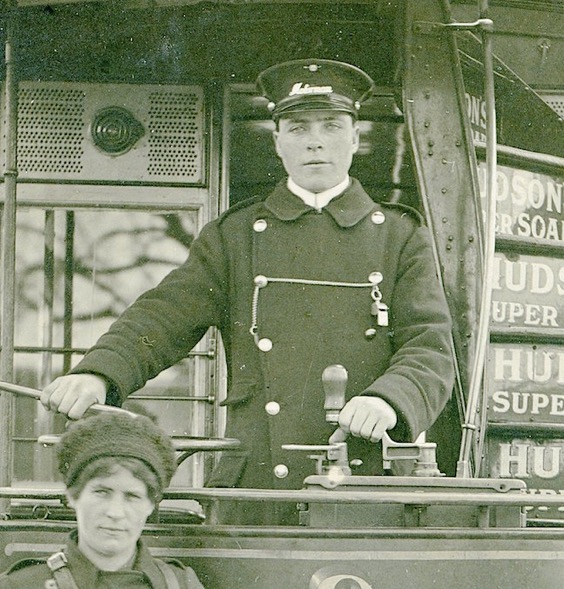
An enlargement of the above photograph showing Charles McKinley. His greatcoat is devoid of insignia, and whilst his cap appears to carry a small badge under the crown, this is probably personal adornment (military) rather than a company issue, as it does not appear on any other photos. Magnification of the photo suggests that the buttons were plain with a scalloped rim.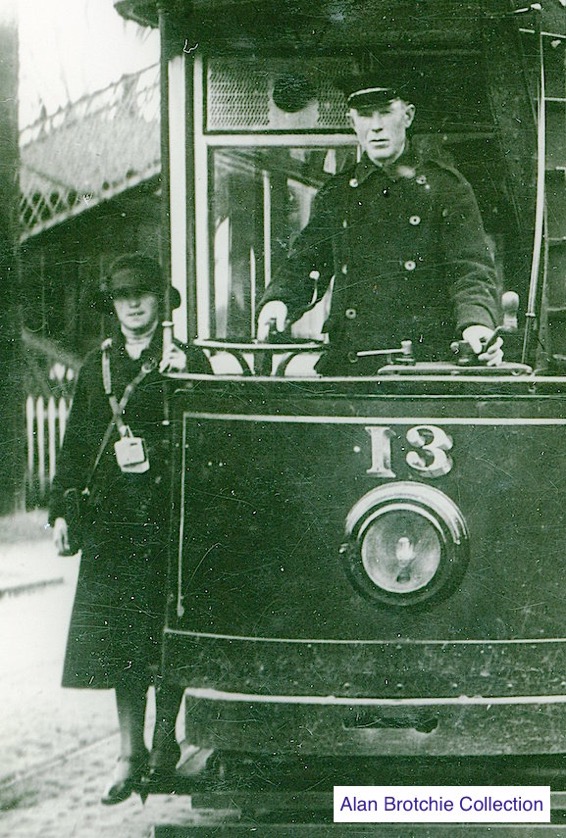
A conductress and a motorman photographed with their charge (No 13) at Balloch Station — photo undated, but certainly taken after 1914. The motorman's greatcoat is devoid of badges, and even the buttons are non-metallic.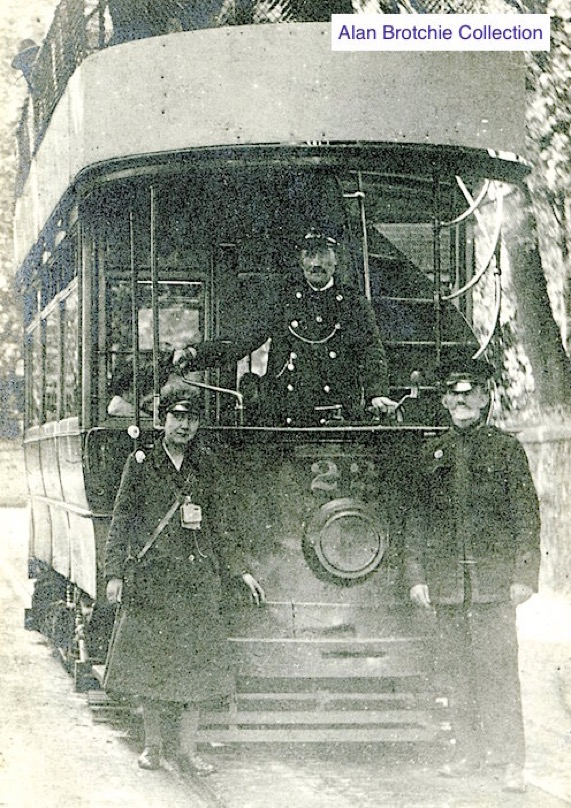
The crew of Tramcar No 22 pose for the cameraman along with an inspector — photo undated, but possibly taken in the mid 1920s.
Senior staff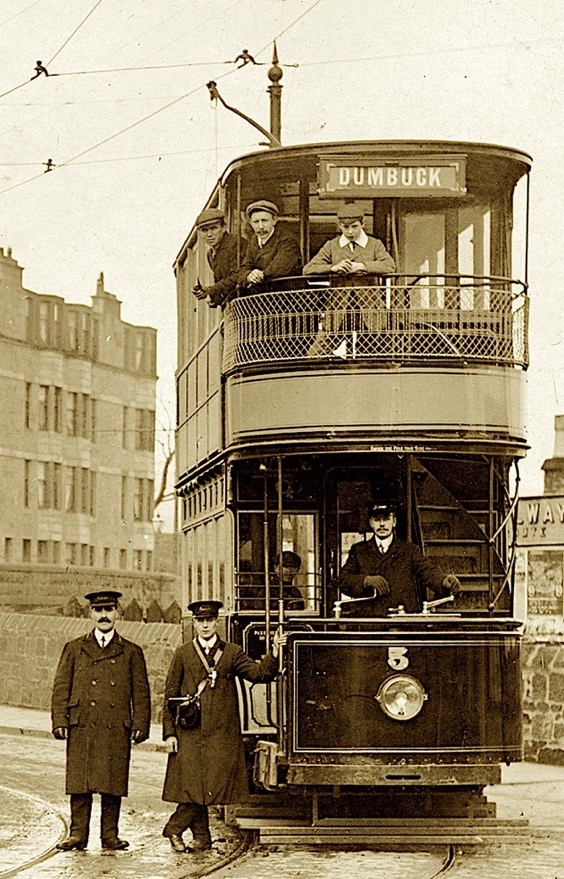
What looks to be a brand-new Tramcar No 5 at what is possibly Dalreoch Toll, with the railway overbridge near Dalreoch Station in the background — photograph undated, but very probably taken around the time of opening. The conductor (centre) and motorman (at the controls) are both wearing the long overcoats issued early on in the tramway's life. The inspector (left) is wearing a double-breasted overcoat bearing embroidered collar insignia, almost certainly his grade, along with a tensioned-crown peaked cap, which again probably bears his grade. Photo courtesy of Vale of Level History.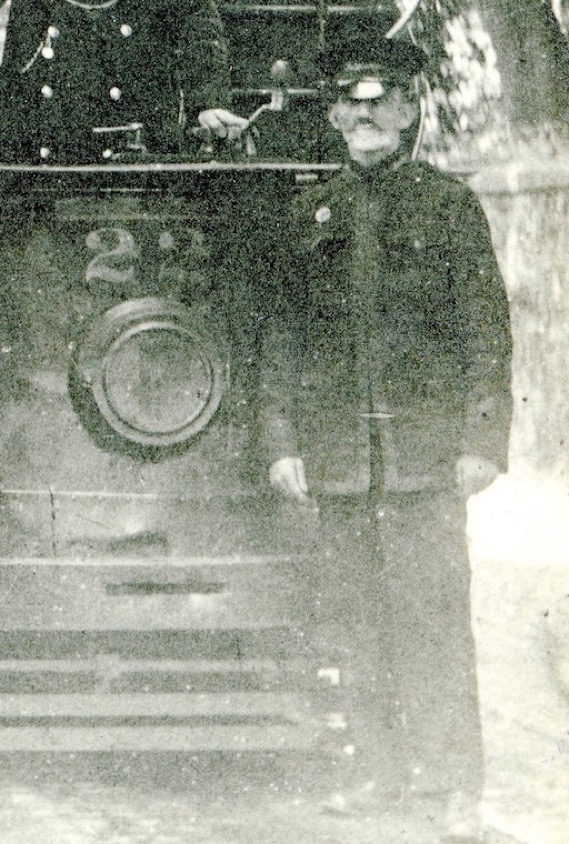
An enlargement of the photograph of Tramcar No 22 (taken in the 1920s) showing the inspector. He is wearing a fairly typical tramway inspector's uniform, with his grade embroidered on each collar and on his cap.
Female staff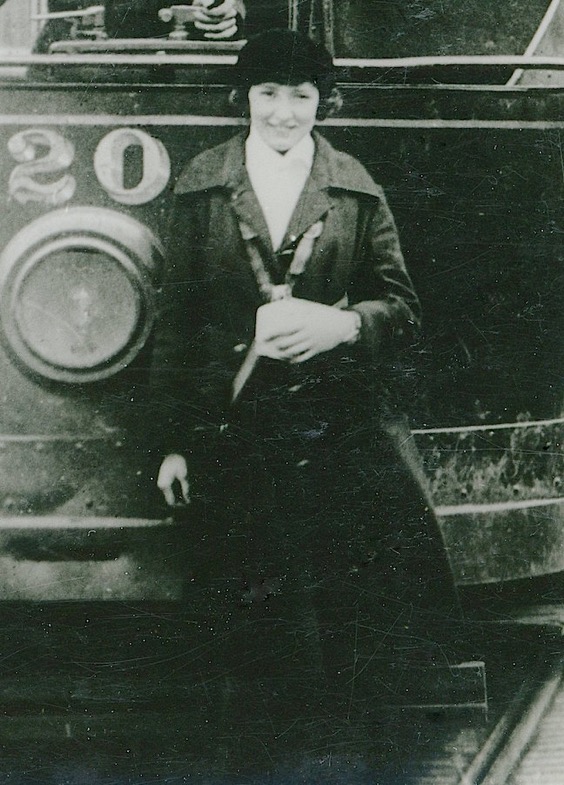
An enlargement of the photograph above of Tramcar 20 showing the conductress. She is clearly wearing informal attire, inclusive of the coat and the bonnet.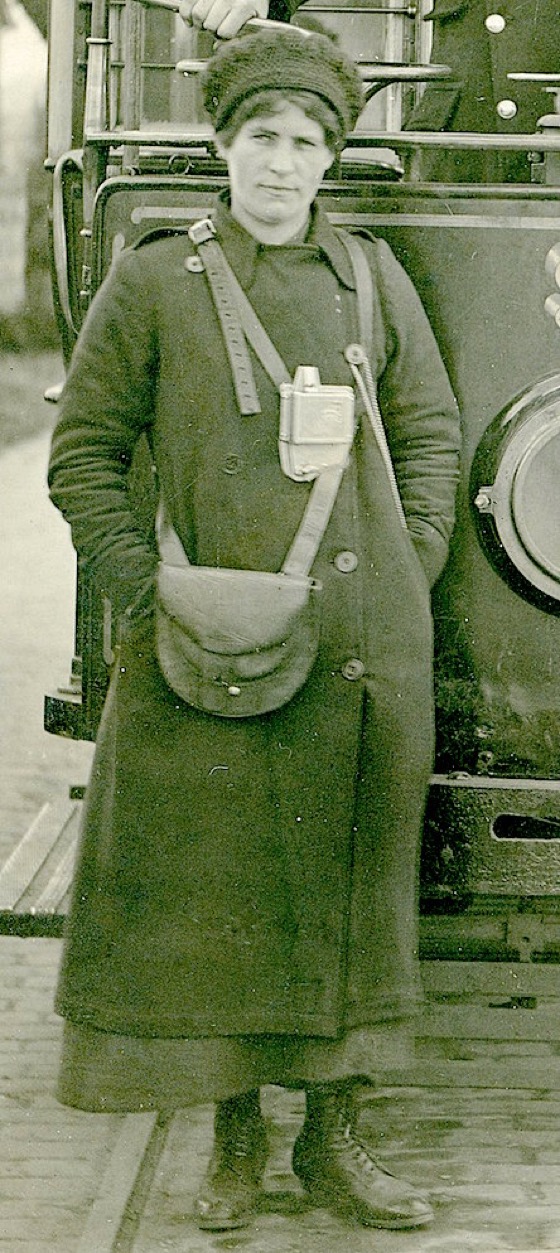
Conductress Helen MacKay photographed in 1915, and taken from the photo of Tramcar No 9 above. Her coat is completely devoid of insignia, suggesting that it was either self-purchased, or that the company simply purchased these without going to the trouble of ordering anything that would mark the wearer out as a tramway employee. Her headgear takes the form of a woollen bonnet, presumably self-knitted!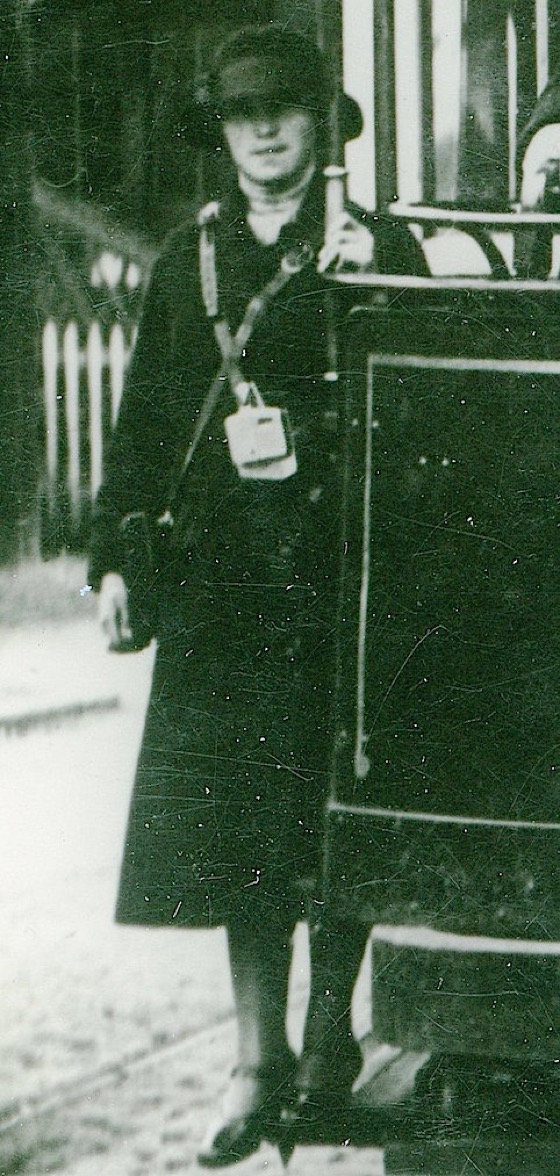
Another blow-up of a photograph above, this time of Tramcar No 13, showing the conductress. Although her outfit has the semblance of a uniform, the fact that it has neither insignia nor metallic buttons would tend to indicate that it was not issued by the company. Her bonnet has a hat band, but again no sign of a badge.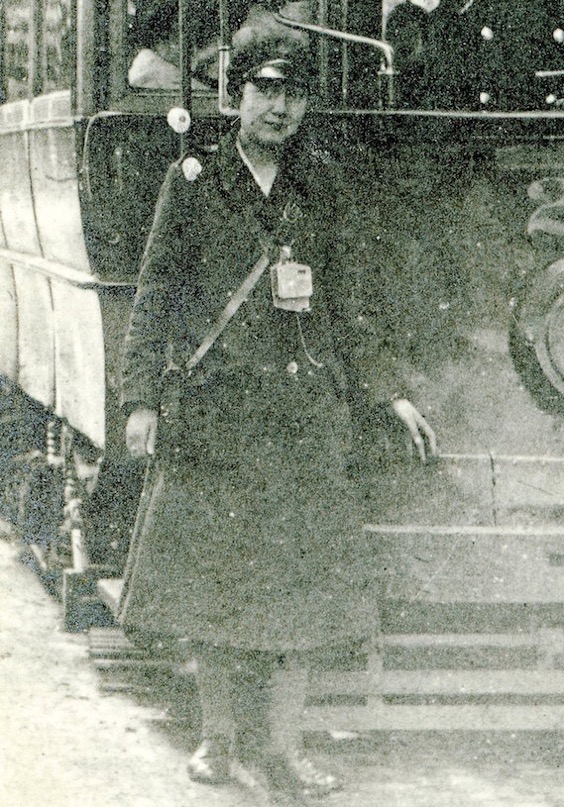
The conductress seen in the photo of Tramcar No 22 above, which was probably taken in the mid 1920s. The poor quality of the photograph makes it difficult to come to any firm conclusions, though she is wearing what appears to be a motor cap (baggy topped with a peak); the coat again appears to be devoid of insignia.